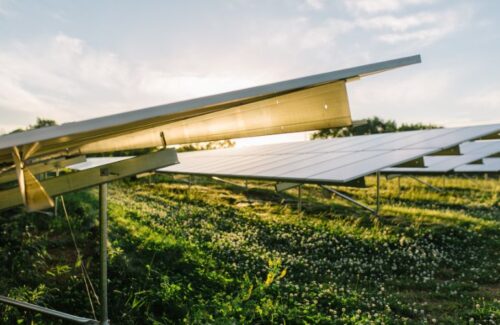 The Bee and Butterfly Habitat Fund recently launched its new Solar Synergy program alongside project partner Monarch Joint Venture. The program works directly with solar developers to strategically design and monitor high-quality pollinator habitats within utility-scale renewable energy projects. Through the generous financial support of corporations and foundations, the program is being offered at no additional cost to the developers.
The Bee and Butterfly Habitat Fund recently launched its new Solar Synergy program alongside project partner Monarch Joint Venture. The program works directly with solar developers to strategically design and monitor high-quality pollinator habitats within utility-scale renewable energy projects. Through the generous financial support of corporations and foundations, the program is being offered at no additional cost to the developers.
“Pollinators are an important keystone species that are in dire need of habitat,” said Peter Berthelsen, executive director of The Bee and Butterfly Habitat Fund. “Through this program, we’ll have an incredible opportunity to work collaboratively with solar developers to not only increase pollinator health and habitat, but to also deliver a set of significant environmental and sustainability benefits that include carbon sequestration, increased soil health, better water quality and more.”
The new Solar Synergy program consists of uniquely designed outcomes that deliver four key benefits to renewable energy projects:
- High-value pollinator seed mixtures: The program uses NextGen Conservation custom seed mixtures, which are designed considering no less than 15 different factors and project objectives. This ensures that not only are the solar project objectives being met, but that the project produces significant pollinator health and habitat benefits. Two different seed mixtures will be used on each project: one for use within the solar array area that is designed to work with each project’s solar panel heights, and one used in the buffer, or open areas of the project, designed with 40+ different native wildflower species. These NextGen seed mixtures not only promote biodiversity, but also greatly enhance soil health and improve water quality within the solar site.
- Extensive monitoring of pollinator health: Considering the massive declines in the number of pollinators, including the monarch butterfly and honey bee, it is more important now than ever before to document the results of these projects. The Monarch Joint Venture will collect baseline and ongoing pollinator and habitat information for Solar Synergy program sites on an annual basis. An extensive list of health and habitat outcomes will be monitored and recorded including the documentation of which floral resources the pollinators are using within the habitat, which pollinator species are present and the abundance of milkweed, a vital resource for monarch butterflies. There is an expected increase in the overall presence of pollinators as well as other wildlife, such as grassland songbirds.
- Carbon sequestration documentation: Through the use of thoughtfully engineered seed mixtures, the ability for these solar sites to sequester a significant amount of carbon is an additional environmental benefit of the program. Baseline and ongoing carbon readings will be used to document carbon sequestration gains. The program will then help connect purchasers of potential carbon credits to each project. The Bee and Butterfly Habitat Fund already has entities waiting in line to purchase carbon credits that may become available on the sites.
- Increased opportunity for honey production: The amount of honey consumed in the U.S. that is actually being produced within the country has decreased over the last decade to just 25%. One of the biggest reasons for the decrease in U.S.-sourced honey production is the lack of access to high-quality forage, or honey bee habitat. Because the Solar Synergy program will be producing a large amount of high-quality pollinator habitat on project sites, there is a unique opportunity to connect solar project developers to commercial beekeepers. Increasing beekeepers’ access to high-quality pollinator habitat can create opportunities to increase the production of domestically sourced honey.
“Overall, we couldn’t be more excited about the program and the interest that has already been shown by both solar developers and end users,” Berthelsen said. “The positive impact potential on the environment using this multi-benefit approach is incredible and the fact that we are able to offer these critical services and support at no cost to the developers is the icing on the cake. By combining our expertise with pollinators and working collaboratively with the renewable energy industry, we can make a huge difference in generating clean energy while documenting pollinator health and habitat success.”
News item from the Bee & Butterfly Habitat Fund



